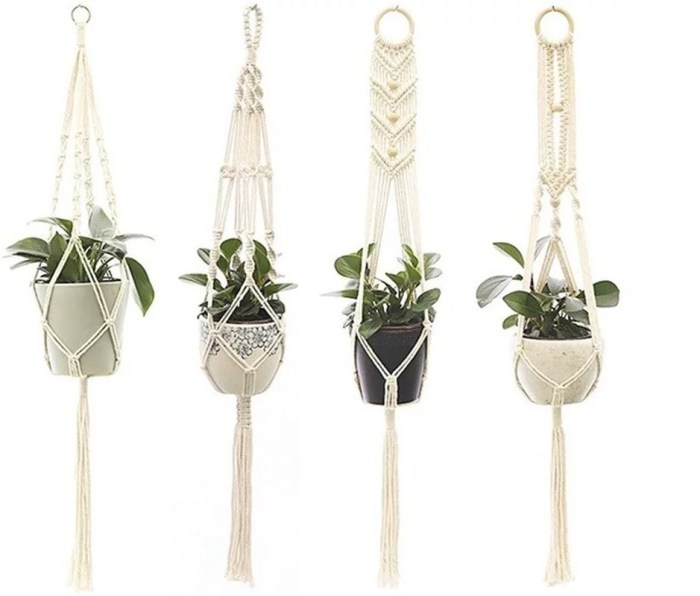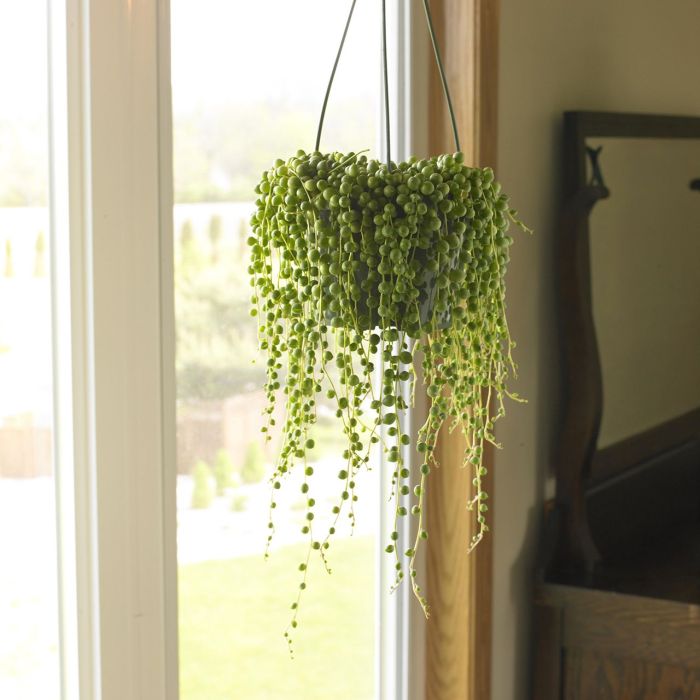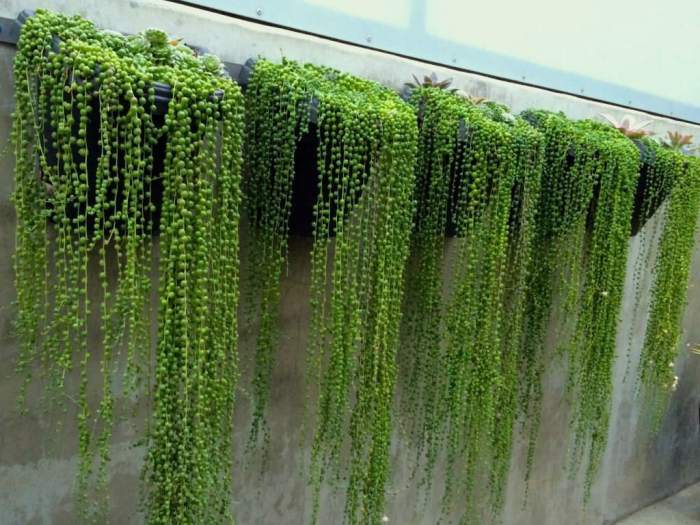Hanging plants with string is an art form that can transform any indoor space into a lush oasis. With a myriad of plant varieties, string options, and creative techniques, the possibilities for creating unique and eye-catching displays are endless.
From trailing vines to cascading ferns, there’s a hanging plant to suit every taste and environment. String provides a versatile and aesthetically pleasing way to suspend these plants, allowing you to create stunning focal points and add a touch of greenery to your home.
Types of Hanging Plants for String
Hanging plants suspended by string add a touch of greenery and vertical interest to any space. When selecting plants for this type of display, consider their growth habits, leaf shapes and sizes, and ideal lighting conditions and watering requirements.
Popular hanging plants for string include:
Spider Plants
- Growth Habit:Produces long, trailing stems with rosettes of arching, variegated leaves.
- Leaf Shape and Size:Long, slender, and variegated with creamy white and green stripes.
- Lighting:Prefers bright, indirect light but can tolerate low light.
- Watering:Water when the top inch of soil feels dry to the touch.
Pothos
- Growth Habit:Vigorous trailing vines with heart-shaped leaves.
- Leaf Shape and Size:Heart-shaped, glossy, and available in various colors, including green, variegated, and yellow.
- Lighting:Thrives in bright, indirect light but can tolerate low light.
- Watering:Allow the top few inches of soil to dry out between waterings.
String of Pearls
- Growth Habit:Trailing succulent with bead-like leaves.
- Leaf Shape and Size:Spherical, pea-sized leaves that resemble strings of pearls.
- Lighting:Prefers bright, indirect light but can tolerate some direct sun.
- Watering:Water sparingly, allowing the soil to dry out completely between waterings.
Selecting the Right String for Hanging Plants

Choosing the right string for hanging plants is crucial for ensuring the plant’s safety, longevity, and aesthetic appeal. Various types of strings offer unique advantages and drawbacks, so understanding their characteristics is essential for making an informed decision.
The strength and durability of the string are paramount. Heavy plants require robust strings that can withstand their weight without breaking or stretching. Jute, hemp, and nylon are excellent choices for large and heavy plants due to their exceptional tensile strength and durability.
Suspending plants with string adds a touch of elegance and charm to any space. Front porches, in particular, benefit from the visual appeal of hanging plants for front porch . They create a welcoming ambiance and can even enhance curb appeal.
Whether you choose trailing varieties or cascading greenery, hanging plants with string are a versatile and stylish way to adorn your porch.
Aesthetic appeal is also an important consideration. Natural materials like jute and hemp provide a rustic and organic look, while synthetic strings like nylon offer a sleek and modern aesthetic. Macrame cords and cotton strings are popular options for creating intricate and decorative hangers.
Selecting the Appropriate String
The size and weight of the plant should guide the selection of the string. Small and lightweight plants can be suspended using thinner strings like cotton or macrame cords. Medium-sized plants require stronger strings like jute or nylon, while heavy plants demand robust options like hemp or galvanized wire.
Creative Stringing Techniques for Hanging Plants: Hanging Plants With String

Harness the versatility of string to elevate the aesthetics of your hanging plant displays. From intricate knotting to vibrant braiding, explore innovative techniques that transform string into a design element.
Knotting Techniques
Master the art of macrame, an ancient knotting technique, to create intricate plant hangers. Experiment with different knots, such as the square knot, half hitch, and lark’s head, to weave unique patterns that support and showcase your plants.
Braiding Techniques
Elevate the visual appeal of your hanging plants with braiding techniques. Combine multiple strands of string in various colors and textures to create eye-catching braids that add depth and character to your display. Consider incorporating beads or charms into the braids for a touch of whimsy.
Incorporating Different String Colors and Textures
Play with the aesthetic impact of your hanging plants by experimenting with different string colors and textures. Choose contrasting hues to create a bold statement or opt for subtle tones to complement the natural beauty of your plants. Incorporate textured strings, such as jute or cotton, to add a rustic or bohemian touch.
Design Ideas for Hanging Plants with String
Incorporating hanging plants with string into interior design adds a touch of nature and greenery to any space. These versatile plants can be suspended from ceilings, walls, or even furniture to create a variety of eye-catching displays.
Hanging plants are a great way to add a touch of greenery to small spaces or to create a focal point in a larger room. They can also be used to improve air quality by removing toxins from the air.
Incorporating Hanging Plants into Different Interior Design Styles
Hanging plants can be incorporated into a variety of interior design styles, from modern to traditional. In modern spaces, hanging plants can be used to add a touch of greenery and texture. In traditional spaces, hanging plants can be used to create a more cozy and inviting atmosphere.
Hanging plants with string is a popular and versatile way to add greenery to your home. If you’re looking for a way to hang your plants without damaging your walls, bunnings plant hook is a great option. These hooks are easy to install and can be used to hang plants of all sizes.
Once you’ve installed your hooks, you can simply hang your plants with string and enjoy the beauty of your new indoor garden.
Hanging Plants in Various Rooms
Hanging plants can be used in a variety of rooms in the home, including living rooms, bedrooms, and kitchens. In living rooms, hanging plants can be used to create a focal point or to add a touch of greenery to a seating area.
In bedrooms, hanging plants can be used to create a more relaxing atmosphere. In kitchens, hanging plants can be used to add a touch of greenery to a cooking space or to create a more inviting atmosphere for dining.
Hanging plants with string are a great way to add a touch of greenery to your home. They can be used to create a vertical garden, or simply to add a pop of color to a corner. If you’re looking for a low-maintenance plant, consider the hanging devils ivy bunnings . This plant is easy to care for and can tolerate a wide range of conditions.
Plus, it’s a great way to add a touch of greenery to your home without taking up too much space. And when it comes to hanging plants with string, the possibilities are endless.
Using Hanging Plants to Create Focal Points, Add Greenery, and Improve Air Quality
Hanging plants can be used to create a variety of effects in a space. They can be used to create a focal point, to add a touch of greenery, or to improve air quality. By choosing the right plants and hanging them in the right way, you can create a beautiful and functional space that you’ll love.
Care and Maintenance of Hanging Plants with String

Maintaining the health and beauty of hanging plants suspended with string requires specific care considerations. Watering, fertilizing, and pruning techniques must be adapted to accommodate their unique growth conditions. Regular monitoring and prompt attention to issues such as pests, diseases, and string damage are crucial for ensuring optimal plant growth.
Watering
Hanging plants with string tend to dry out more quickly than those in traditional pots due to increased air circulation and exposure to sunlight. Water thoroughly when the soil feels dry to the touch, allowing excess water to drain through the drainage holes.
Avoid overwatering, as soggy soil can lead to root rot.
Fertilizing
Fertilize hanging plants monthly during the growing season with a balanced liquid fertilizer diluted to half strength. Avoid over-fertilizing, as it can burn the roots.
Pruning, Hanging plants with string
Regular pruning encourages bushier growth and removes dead or damaged leaves. Prune by snipping stems just above a leaf node, using sharp, clean shears.
Monitoring and Troubleshooting
Regularly inspect hanging plants for pests, such as aphids or spider mites, and treat promptly with appropriate insecticides. Address diseases by removing infected leaves and treating with fungicides. Monitor string for signs of wear or damage and replace it as needed to prevent the plant from falling.
Last Recap

Hanging plants with string is a simple yet effective way to enhance the beauty and ambiance of any indoor space. By experimenting with different plant varieties, string types, and creative techniques, you can create unique and stylish displays that will bring life and freshness to your home.
FAQ Compilation
What are the best hanging plants for string?
Some popular hanging plants for string include pothos, spider plants, philodendrons, ferns, and ivy.
What type of string should I use for hanging plants?
Macrame cord, jute twine, and cotton rope are all popular choices for hanging plants due to their strength and durability.
How do I hang plants with string?
There are a variety of ways to hang plants with string, including using knots, braids, and macrame techniques.